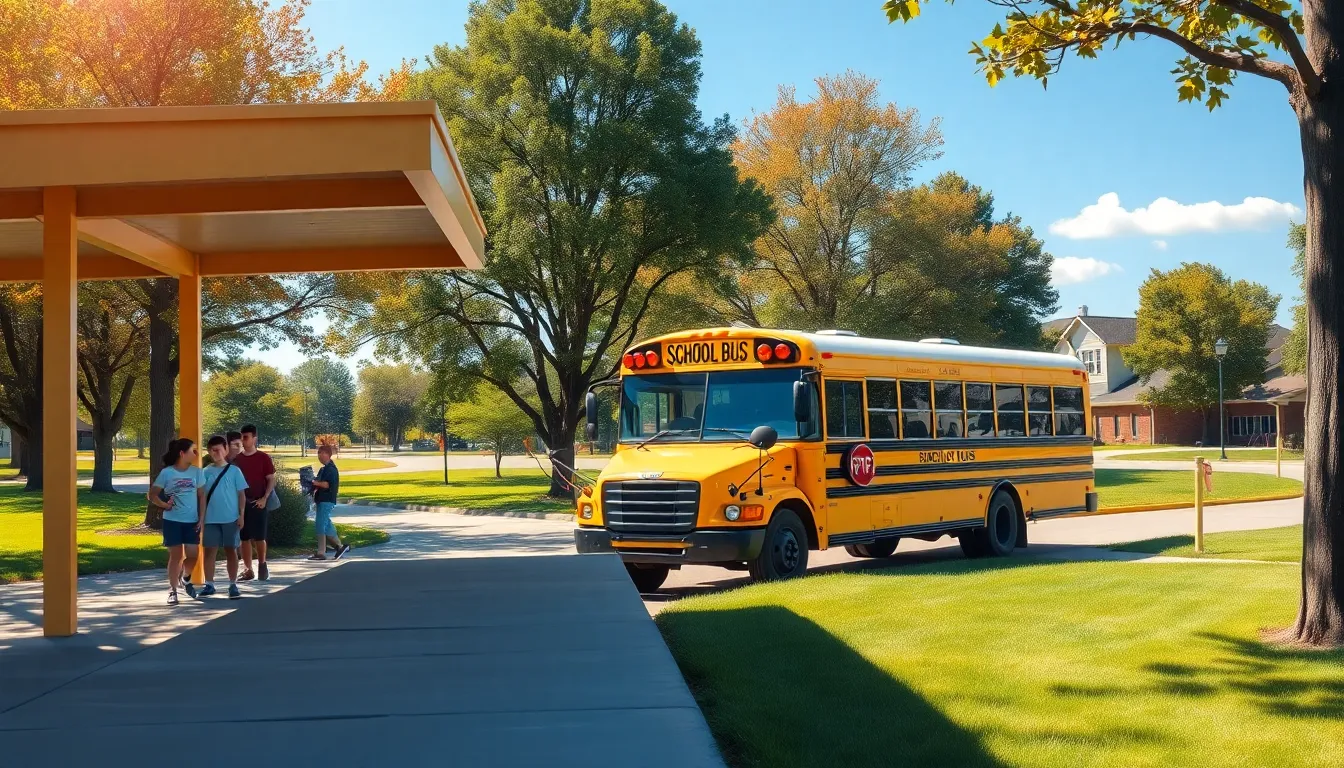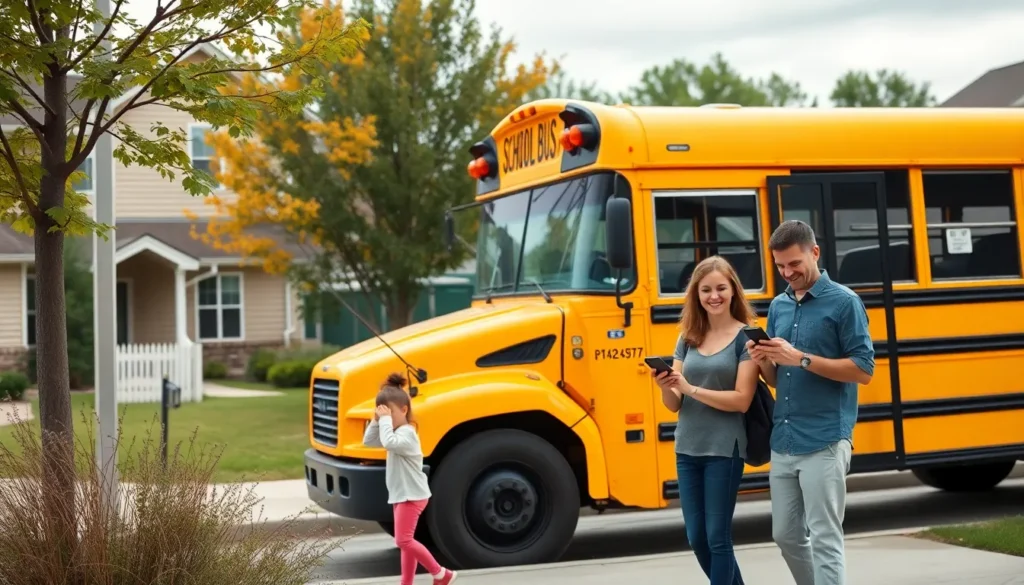Table of Contents
ToggleImagine a world where school buses glide through traffic like well-oiled machines, picking up kids on time and keeping parents from losing their minds. School bus optimization isn’t just a buzzword; it’s the secret sauce that transforms chaotic morning routines into smooth rides. With a sprinkle of smart routing and a dash of technology, schools can turn the daily school run into a stress-free experience.
Overview of School Bus Optimization
School bus optimization involves the integration of technology and strategic planning to improve transport efficiency for students. Effective routing reduces travel time, ensuring students spend less time commuting and more time in the classroom. Data-driven approaches identify the best routes using factors like traffic patterns, bus capacity, and student locations.
Adopting real-time tracking systems enhances communication between parents, schools, and bus drivers. This creates a streamlined process for parents to know exactly when their children will arrive at stops. By implementing GPS technology, school districts can monitor bus locations, ensuring timely arrivals and departures.
Optimized schedules align with school start and end times, accommodating after-school activities while minimizing delays. Route adjustments based on student attendance can further increase efficiency, enabling flexible responses to changing needs.
Analyzing historical data provides insights into peak traffic times, helping planners make informed decisions. Implementing smart algorithms can automate route planning, making it faster and more accurate.
Ultimately, school bus optimization leads to safer transportation experiences for students. Improved operational efficiency benefits school districts, reducing transportation costs and increasing satisfaction among families. Enhanced services contribute to a positive educational environment, allowing for focused learning without the stresses of chaotic commutes.
Importance of Efficient School Bus Routes

Efficient school bus routes play a crucial role in enhancing transportation systems for students. Optimized routes contribute significantly to financial savings for schools, leading to better resource allocation.
Cost Savings for Schools
Savings from efficient school bus routes arise through reduced fuel consumption, lower maintenance costs, and decreased labor expenses. Schools can experience up to 30% savings by optimizing fleet management and consolidating routes. Enhanced routing allows for fewer buses on the road, which minimizes operational costs while maintaining a reliable transportation service. Resources saved can then be redirected to educational initiatives, improving overall student experiences.
Environmental Impact
Optimized bus routes positively influence environmental sustainability. By reducing the number of vehicles and the total distance traveled, emissions decrease, leading to improved air quality. Efficient transportation systems can cut greenhouse gas emissions by an estimated 20%. Fewer buses on the road contribute to less congestion as well, paving the way for a healthier community. Schools adopting these practices showcase their commitment to environmental responsibility, fostering awareness among students and families.
Challenges in School Bus Optimization
Challenges in school bus optimization impact the efficiency of student transportation. Understanding these obstacles helps stakeholders navigate potential issues effectively.
Traffic and Safety Concerns
Traffic congestion poses significant challenges during morning and afternoon school hours. Increased vehicle volume leads to delays, affecting on-time arrivals. Safety remains a major priority, as crowded roads can increase the risk of accidents. Optimized routes need to consider high-traffic areas and peak times to minimize exposure. Real-time traffic data improves decision-making, ensuring that buses avoid bottlenecks. Developing safe drop-off and pick-up zones enhances student security, allowing parents to have peace of mind.
Route Planning Limitations
Route planning limitations can hinder the effectiveness of school bus schedules. Adjustments must accommodate various factors, such as student locations and school calendars. Unforeseen circumstances, like weather conditions or road closures, complicate planning efforts. Historical data analysis informs planners but may not always predict every scenario. Advanced software can enhance route planning accuracy but relies on quality data input to function effectively. Collaborating with transportation experts often leads to more reliable routing solutions.
Technologies and Solutions
Technological advancements play a crucial role in school bus optimization. These solutions enhance efficiency while improving communication among parents, schools, and transport providers.
GPS and Real-Time Tracking
GPS technology enables precise real-time tracking of school buses. Parents gain access to live updates, knowing when their children will arrive at designated stops. Schools benefit from improved safety as bus drivers receive updates on traffic and road conditions. Enhanced awareness reduces confusion and anxiety during daily commutes. Reliable tracking systems also foster accountability, ensuring that bus schedules are maintained effectively.
Route Optimization Software
Route optimization software utilizes data-driven algorithms to streamline bus routes. Such software analyzes historical data, patterns, and student attendance to create efficient routes. Planners often achieve up to 30% savings through effective fleet management and consolidation. Additionally, software updates accommodate real-time factors, including weather and traffic, allowing for quick adjustments when necessary. Enhanced software solutions lead to more predictable schedules, creating a positive impact on students and parents.
Case Studies and Success Stories
Various school districts demonstrate successful school bus optimization practices. In one instance, a district in California implemented a routing software that established more efficient paths. This change led to a reduction in fuel consumption by approximately 25%, resulting in significant financial savings.
Another success story comes from a Texas school system that adopted real-time tracking systems. As a result, parents received live updates about bus locations, which improved overall communication. The implementation of this technology resulted in increased student safety and less anxiety for families during pick-up and drop-off times.
In an Ohio district, data-driven modeling transformed bus routes. Historical data analysis revealed peak congestion areas, enabling planners to adjust schedules accordingly. This adjustment resulted in a reduction of delays by up to 30%. Such improvements not only enhanced transit times but also created a more streamlined experience for students.
Furthermore, an initiative in Florida focused on sustainable practices. By optimizing routes, the district cut greenhouse gas emissions by an estimated 20%. The environmental impact highlighted the benefits of responsible transport practices, fostering awareness among students about sustainability.
Overall, these examples illustrate how strategic planning and technology integration yield remarkable outcomes. More efficient school bus systems provide financial benefits that contribute to school budgets. They also enhance safety and create a more positive atmosphere, ultimately benefiting students and parents alike.
School bus optimization represents a significant advancement in student transportation. By leveraging technology and strategic planning, it transforms chaotic commutes into smooth and efficient experiences. The benefits extend beyond convenience, offering financial savings and environmental advantages that resonate with schools and families alike.
As districts face challenges like traffic congestion and unpredictable conditions, embracing innovative solutions becomes essential. Real-time tracking and data-driven routing not only enhance safety but also foster better communication among all parties involved.
The case studies highlight the tangible success of these initiatives, proving that optimization isn’t just a trend—it’s a necessary evolution in how schools manage transportation. Adopting these practices ensures a brighter future for students, parents, and the environment.







